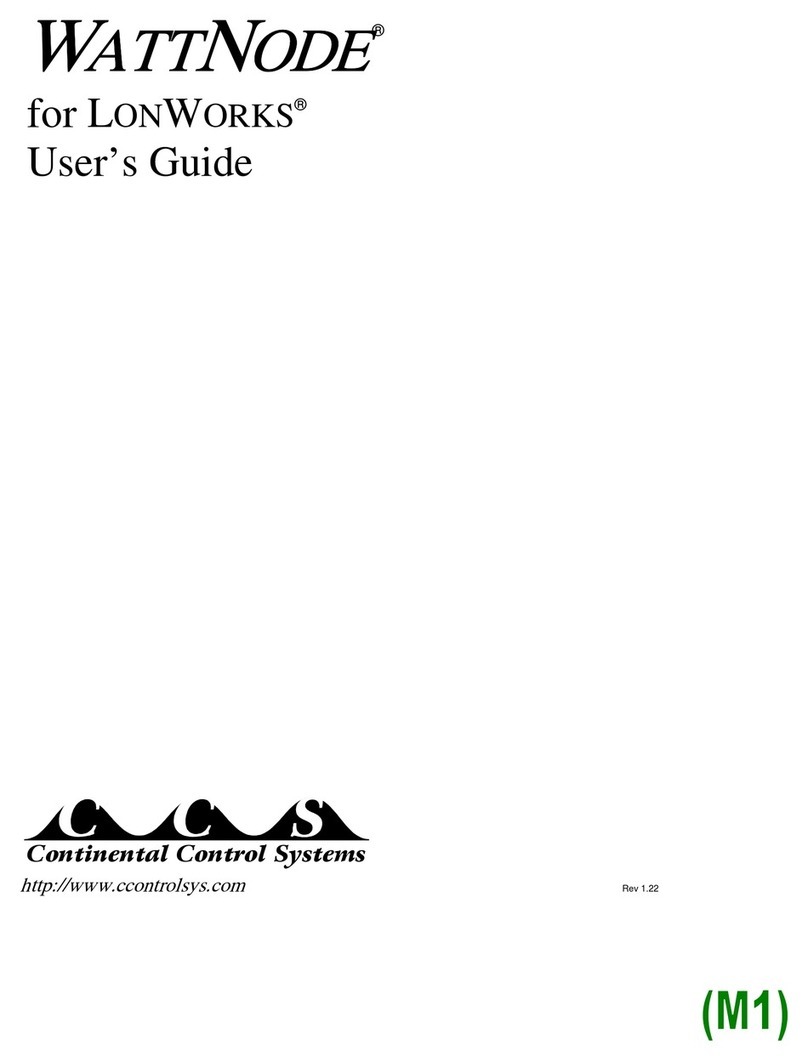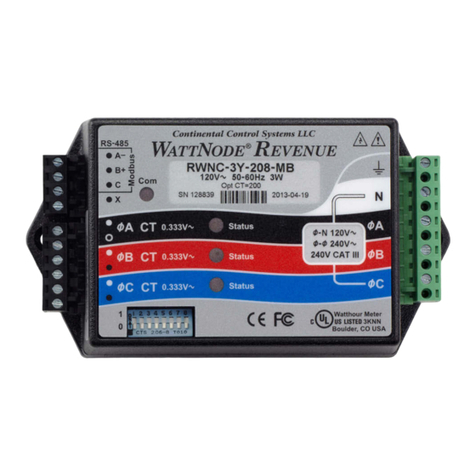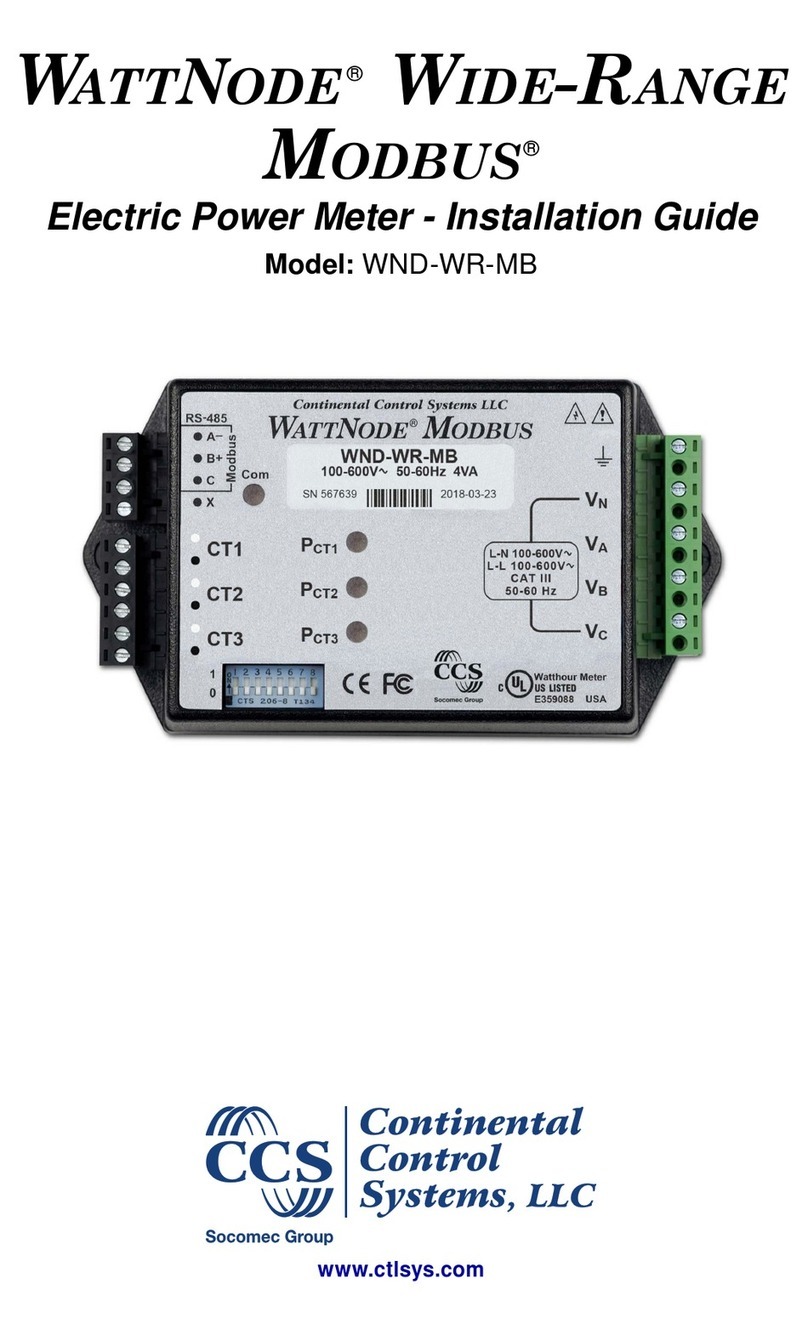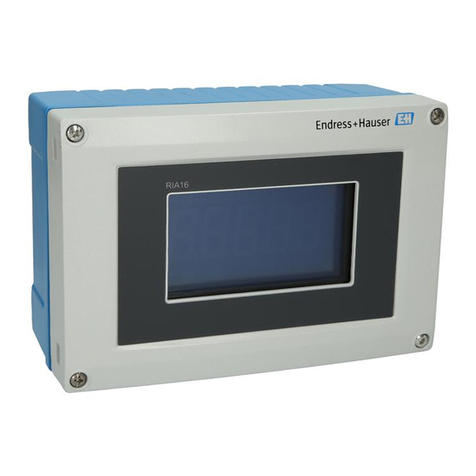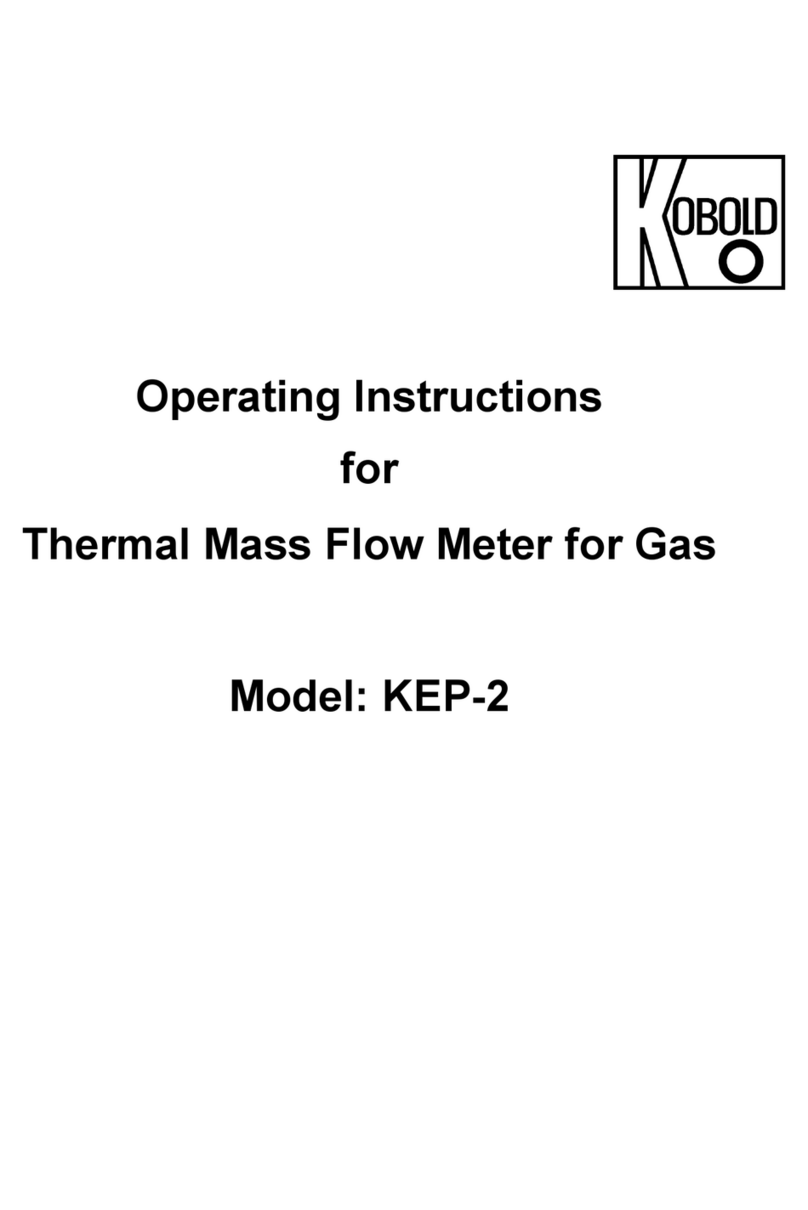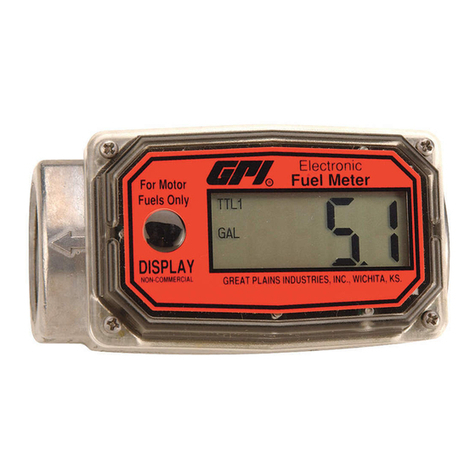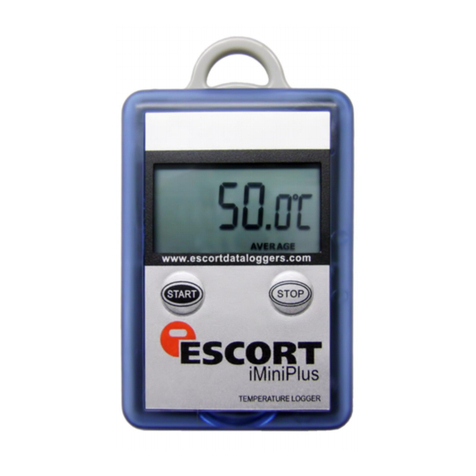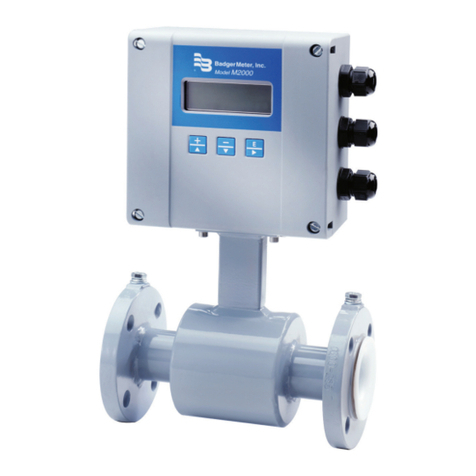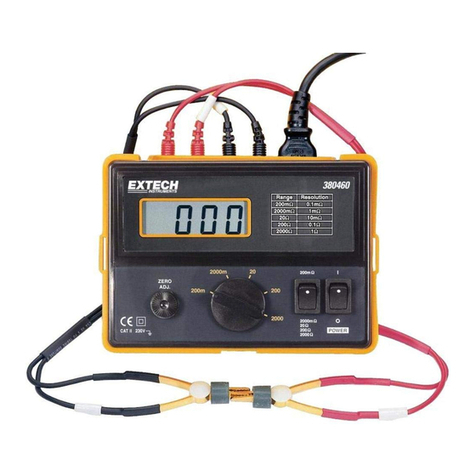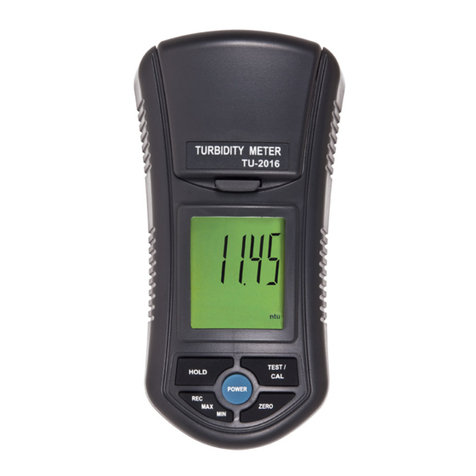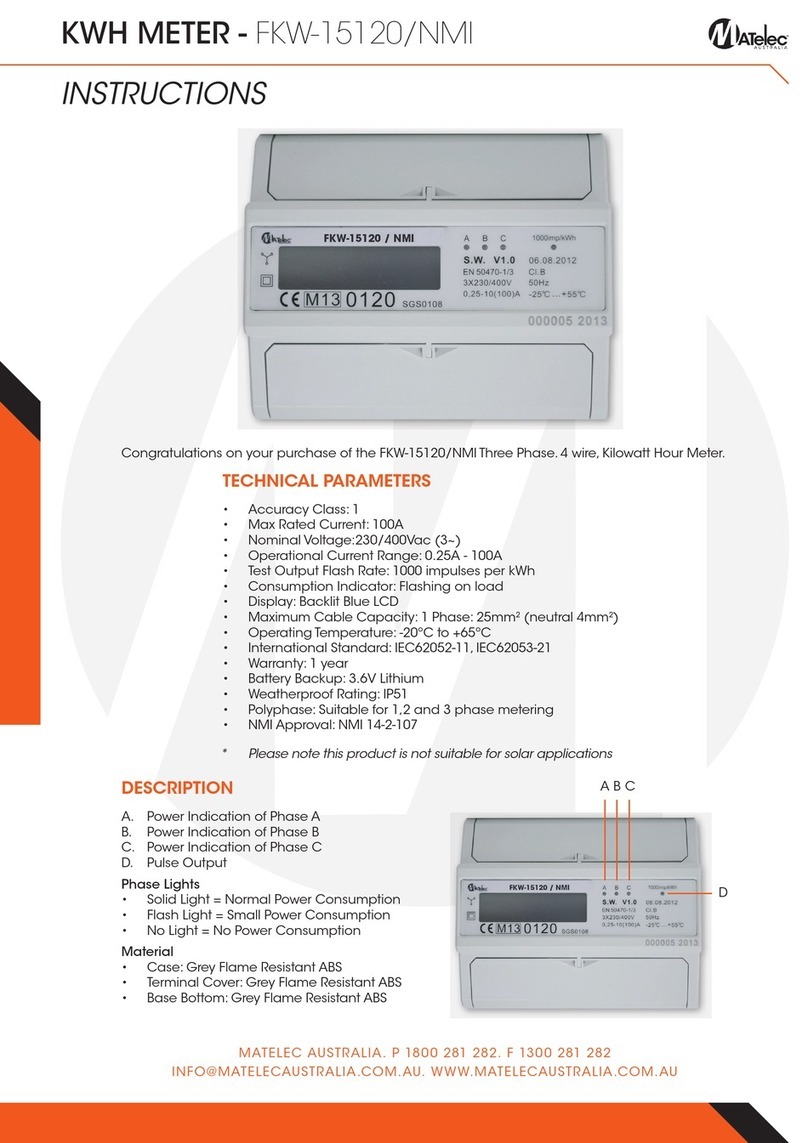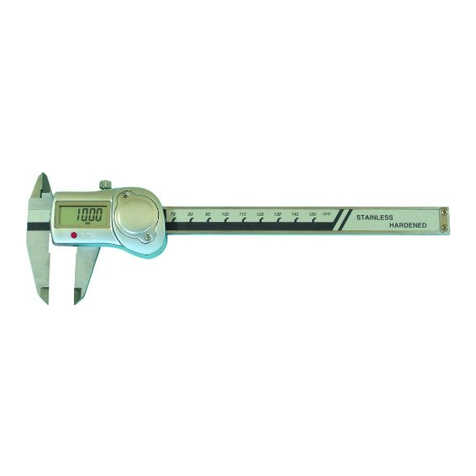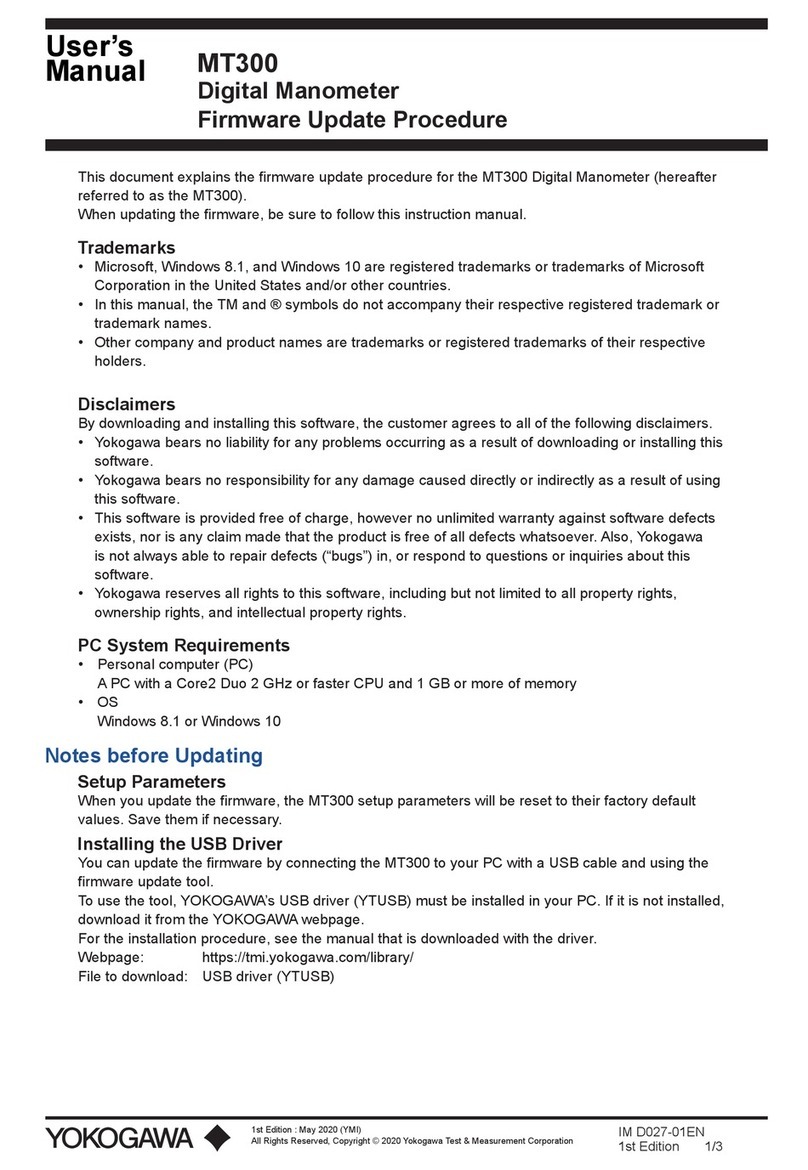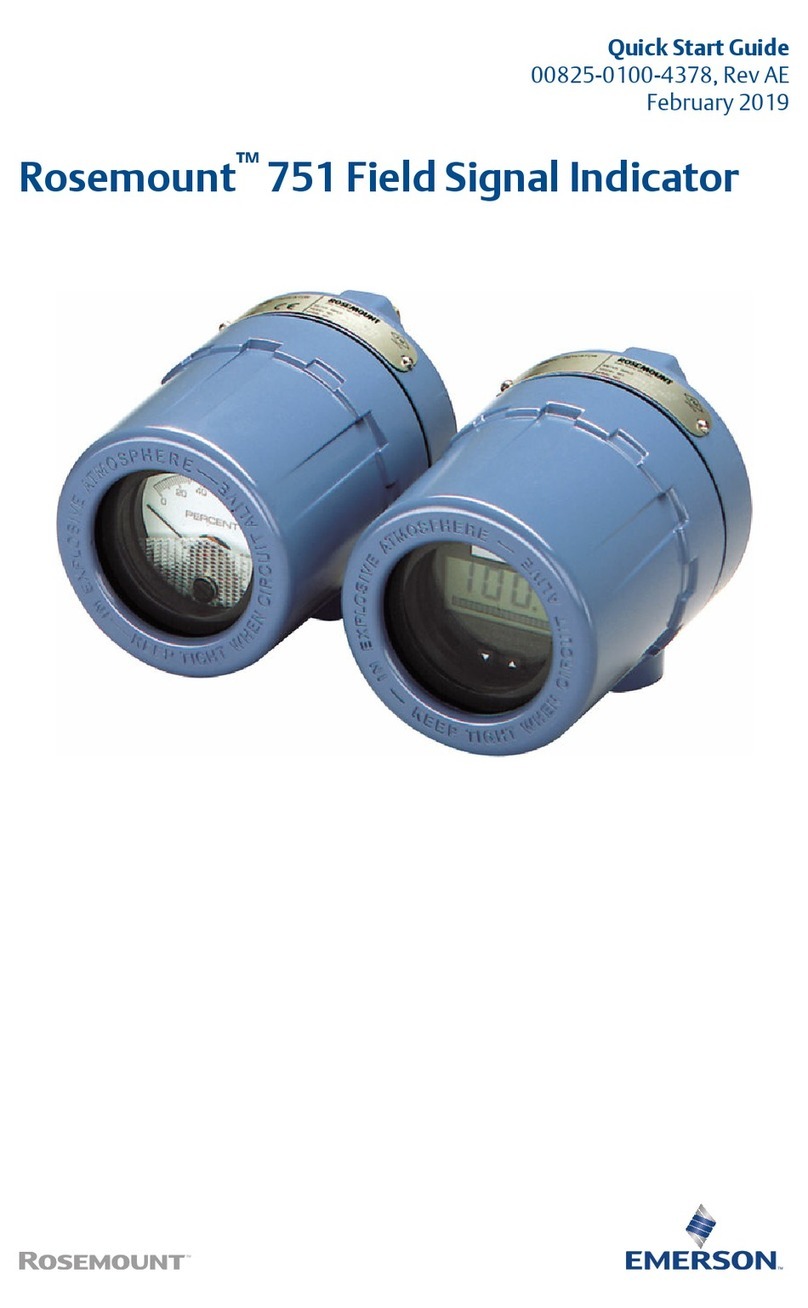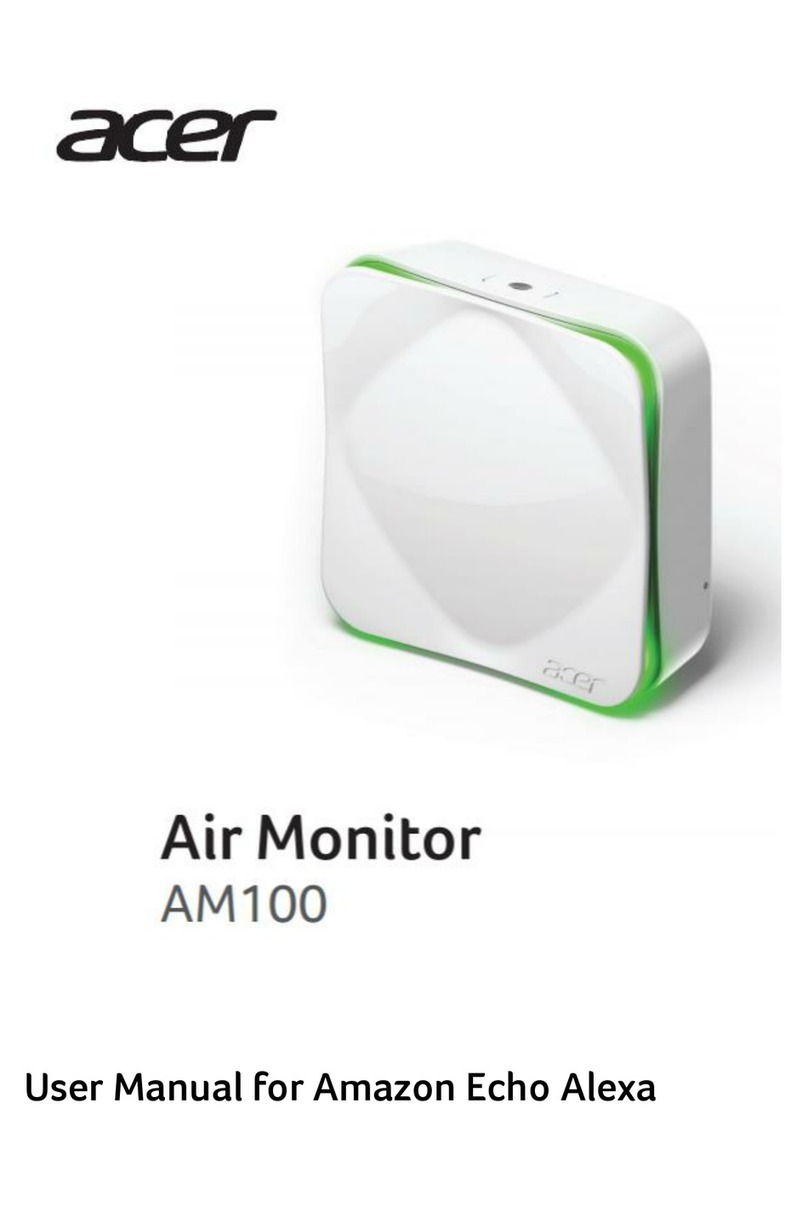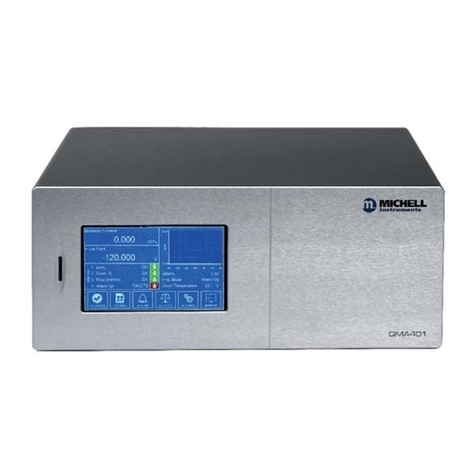CCS WattNode Plus WNC-3Y-208-FT10 User manual

2
FCC Information
This equipment has been tested and complies with the limits for a Class B digital device, pursu-
ant to part 15 of the FCC Rules. Operation is subject to the following two conditions: (1) This
device may not cause harmful interference, and (2) this device must accept any interference
received, including interference that may cause undesired operation.
The FCC limits are designed to provide reasonable protection against harmful interference in a
residential installation. This equipment generates, uses and can radiate radio frequency energy
and, if not installed and used in accordance with the instructions, may cause harmful interfer-
ence to radio communications. However, there is no guarantee that interference will not occur in
a particular installation. If this equipment does cause harmful interference to radio or television
reception, which can be determined by turning the equipment off and on, the user is encouraged
to try to correct the interference by one or more of the following measures:
●Reorient or relocate the receiving antenna.
●Increase the separation between the equipment and receiver.
●Connect the equipment into an outlet on a circuit different from that to which the receiver is
connected.
●Consult the dealer or an experienced radio/TV technician to help.
Information in this document is subject to change without notice.
©2009-2011 Continental Control Systems, LLC. All rights reserved.
Printed in the United States of America.
Document Number: WNC-FT10-3.37b
Revision Date: November 30, 2011
Continental Control Systems, LLC.
3131 Indian Rd.
Boulder, CO 80301
(303) 444-7422
FAX: (303) 444-2903
E-mail: techsupport@ccontrolsys.com
Web: http://www.ccontrolsys.com
WattNode is a registered trademark of Continental Control Systems, LLC.
LonWorks, Echelon, Neuron, LonTalk, LON, LNS, and LonMaker are registered trademarks of Echelon
Corporation.
LonMark and the LonMark Logo are managed, granted, and used by LonMark International under a
license granted by Echelon Corporation.
Tridium, JACE, Niagara Framework, NiagaraAX and Vykon are registered trademarks of Tridium Inc.

Contents 3
Contents
Overview ................................................................................................................................5
Measurements ................................................................................................................................ 5
Communication ............................................................................................................................... 5
Options ........................................................................................................................................... 5
Current Transformers....................................................................................................................... 6
Additional Literature......................................................................................................................... 6
Front Label ...................................................................................................................................... 6
Installation .............................................................................................................................9
Precautions ..................................................................................................................................... 9
Electrical Service Types..................................................................................................................10
Single-Phase Two-Wire with Neutral .........................................................................................10
Single-Phase Three-Wire (Mid-Point Neutral) ............................................................................11
Single-Phase Two-Wire without Neutral ....................................................................................12
Three-Phase Four-Wire Wye.....................................................................................................13
Three-Phase Three-Wire Delta Without Neutral.........................................................................14
Three-Phase Four-Wire Delta (Wild Leg) ...................................................................................14
Grounded Leg Service .............................................................................................................14
Mounting........................................................................................................................................15
Selecting Current Transformers ......................................................................................................16
Connecting Current Transformers...................................................................................................17
Circuit Protection............................................................................................................................18
Connecting Voltage Terminals.........................................................................................................19
Connecting LonWorks Network Wiring............................................................................................19
Installation Summary ..................................................................................................................... 20
Service LED .................................................................................................................................. 20
Communication Troubleshooting ....................................................................................................21
Measurement Troubleshooting....................................................................................................... 22
Network Configuration ........................................................................................................25
Identifying the WattNode ............................................................................................................... 25
Network Reinitialization.................................................................................................................. 25
Operating Instructions.........................................................................................................26
Quick Start.................................................................................................................................... 26
WattNode Basic Configuration ................................................................................................ 26
Verify Operation ...................................................................................................................... 26
Measurement Overview........................................................................................................... 26
Network Variables ..........................................................................................................................27
Authentication ..........................................................................................................................27
General Variables (NodeObject) ..................................................................................................... 28
Energy Variables............................................................................................................................ 29
Power Variables............................................................................................................................. 30
Demand Variables (DemandMeas) ..................................................................................................31
Voltage Variables ........................................................................................................................... 33
Frequency Register........................................................................................................................ 33
Current Registers .......................................................................................................................... 33
Power Factor Registers.................................................................................................................. 33
Reactive Power Registers .............................................................................................................. 34
Configuration Properties................................................................................................................ 34
Calibration Configuration Properties ........................................................................................ 36

4
WattNode Errors.............................................................................................................................37
Maintenance and Repair.................................................................................................................37
Specifications ......................................................................................................................38
Models .......................................................................................................................................... 38
Model Options ........................................................................................................................ 38
Firmware ................................................................................................................................. 38
Accuracy................................................................................................................................. 38
Measurement ................................................................................................................................ 39
Electrical ....................................................................................................................................... 40
Certifications ..................................................................................................................................41
Environmental.................................................................................................................................41
Mechanical.....................................................................................................................................41
Current Transformers......................................................................................................................41
Warranty...............................................................................................................................43
Limitation of Liability ...................................................................................................................... 43

Overview 5
Overview
Congratulations on your purchase of the WattNode®Plus for LonWorks®watt/watt-hour trans-
ducer. The WattNode meter offers precision energy and power measurements in a compact
package. It enables you to make power and energy measurements within existing electric service
panels avoiding the costly installation of subpanels and associated wiring. It is designed for use
in demand side management (DSM), sub-metering, and energy monitoring applications. Models
are available for single-phase, three-phase wye, and three-phase delta configurations for voltages
from 120 Vac to 600 Vac at 50 and 60Hz.
The WattNode®Plus for LonWorks is LonMark®3.4 certified, ensuring plug-and-play interoper-
ability on LonWorks networks.
Continental Control Systems also provides a free LNS plug-in for use with the WattNode meter.
The plug-in simplifies configuration and browsing.
Measurements
The WattNode Plus transducer measures the following:
●True RMS Power: (Watts) Phase A, Phase B, Phase C, Sum
●Reactive Power: (VARs) Phase A, Phase B, Phase C, Sum
●Power Factor: Phase A, Phase B, Phase C, Average
●True RMS Energy: (Kilowatt-hours) Phase A, Phase B, Phase C, Sum
●Reactive Energy: (kVAR-hours) Sum
●AC Frequency: (Hertz)
●RMS Voltage: (Volts) Phase A, Phase B, Phase C
●RMS Current: (Amps) Phase A, Phase B, Phase C
●Demand and Peak Demand: (Watts)
Communication
The WattNode meter communicates on a LonWorks TP/FT-10 free topology twisted-pair network
using Echelon’s®LonTalk®network protocol. Network variables interface the WattNode to the
network. Each device on the network may have both input and output network variables. Output
network variables may be polled or bound (connected) to input network variables of the same
type. Whenever an output network variable is updated, the new value is propagated over the
network, and all devices which have input network variables bound to the updated output will
update their internal copies of the variable.
Options
The WattNode for LonWorks meter can be ordered with several options. For more details and
documentation, see article WattNode Plus for LonWorks - Options on our website.
●Option CT=xxx - Factory configure xxx as the nciCtAmps value.
●Option PT - Improves support for potential transformers (PTs), making it easier to
use the WattNode meter with medium voltage services. Specifically, Option PT adds
a configuration property UCPTptRatio which configures the ratio of the external PT,
allowing the meter to automatically scale the voltage, power, and energy readings. See
WattNode LonWorks - Option PT.
●Option B - Emulates the interface and behavior of the original WNB series WattNode Plus
models (model numbers WNB-xx-xxx-FT10).
●Option BI - Emulates the interface and behavior of the original WNB series WattNode Plus
models (model numbers WNB-xx-xxx-FT10) with 16 bit integer network variables (SNVTs).
●Logger - Adds data logging and a real-time clock. See WattNode Logger for LonWorks.


Overview 7
C: Neutral. On wye models, this terminal must be connected to neutral. On delta models, it is
good practice to connect this terminal to the safety ground terminal using a short jumper wire.
D, E, F: Mains line inputs. One or more of these terminals are connected to the mains lines. For
three phase measurement, the ØA(phase A), ØB(phase B), and ØC(phase C) terminals are
used for the three phases. On wye WattNode models, the meter is powered from the Nand ØA
terminals. On delta models, the meter is powered from the ØAand ØBterminals.
G: Line voltage measurement ratings. This block lists the nominal line-to-neutral “Ø-N 120V~”
voltage, line-to-line “Ø-Ø 240V~” voltage, and the rated measurement voltage and category
“240V CAT III” for this model. See Specifications – Electrical (p. 40)for more information
about the measurement voltage and category.
H: UL Listing mark. This shows the UL and cUL (Canadian) listing mark and number “3KNN”.
I: FCC Mark. This logo indicates that the meter complies with part 15 of the FCC rules.
J: Current transformer (CT) voltage rating. These markings “0.333V~” indicate that the meter
must be used with CTs that generate a full-scale output voltage of 0.33333 Vac (333.33 mil-
livolts AC).
K, L, M: Current transformer (CT) inputs. These indicate CT screw terminals. Note the white
and black circles at the left edge of the label: these indicate the color of the CT wire that should
be inserted into the corresponding screw terminal. The terminals marked with black circles are
connected together internally.
N: FT10 wiring terminals. These connect to the LonWorks FT-10 network. They are polarity
insensitive.
O: LonWorks service LED. The LonWorks service LED indicates network status; see Service
LED (pg 26). Immediately below the LED on the side of the housing is the service button, used
to identify the WattNode meter on the LonWorks network.
P: Firmware version. This indicates the WattNode meter’s firmware version.
Q: Serial number. This shows the WattNode meter’s serial number.
R: LonMark. This logo indicates that the meter meets LonMark interoperability guidelines, v3.4.
S: Mains supply rated voltage. This is the rated supply voltage for this model. The V~indicates
AC voltage. For wye models, this voltage should be applied between the Nand ØAterminals.
For delta models, this voltage should be applied between the ØAand ØBterminals.
T: Neuron ID. This is the Neuron®ID (prefixed by “NI”), which is a unique 64 bit hexadecimal
number assigned to each LonWorks device.
U: Mains frequencies. This indicates the rated mains frequencies for the meter.
V: Maximum rated power. This is the maximum power consumption (watts) for this model.
X: CE Mark. This symbol indicates that the WattNode meter complies with the regulations of the
European Union for Product Safety and Electro-Magnetic Compatibility.
Y: Caution, risk of electrical shock. This symbol indicates that there is a risk of electric shock
when installing and operating the meter if the installation instructions are not followed correctly.
Z: Attention - consult Manual. This symbol indicates that there can be danger when installing
and operating the meter if the installation instructions are not followed correctly.



10 Installation
Electrical Service Types
Below is a list of service types, with connections and recommended models. Note: the ground
connection improves measurement accuracy, but is not required for safety.
Model Type Line-to-
Neutral
Line-to-
Line
Electrical
Service Types
WNC-3Y-208-FT10 Wye 120 Vac 208–240
Vac
1 Phase 2 Wire 120V with neutral
1 Phase 3 Wire 120V/240V with neutral
3 Phase 4 Wire Wye 120V/208V with neutral
WNC-3Y-400-FT10 Wye 230 Vac 400 Vac 1 Phase 2 Wire 230V with neutral
3 Phase 4 Wire Wye 230V/400V with neutral
WNC-3Y-48 0 -FT10 Wye 277 Vac 480 Vac 3 Phase 4 Wire Wye 277V/480V with neutral
1 Phase 2 Wire 277V with neutral
WNC-3Y-6 0 0 -FT10 Wye 347 Vac 600 Vac 3 Phase 4 Wire Wye 347V/600V with neutral
WNC-3D-240-FT10 Delta
or Wye
120 –140
Vac
208–240
Vac
1 Phase 2 Wire 208V (no neutral)
1 Phase 2 Wire 240V (no neutral)
1 Phase 3 Wire 120V/240V with neutral
3 Phase 3 Wire Delta 208V (no neutral)
3 Phase 4 Wire Wye 120V/208V with neutral
3 Phase 4 Wire Delta 120/208/240V with neutral
WNC-3D-400-FT10 Delta
or Wye 230 Vac 400 Vac 3 Phase 3 Wire Delta 400V (no neutral)
3 Phase 4 Wire Wye 230V/400V with neutral
WNC-3D-480-FT10 Delta
or Wye 277 Vac 480 Vac
3 Phase 3 Wire Delta 480V (no neutral)
3 Phase 4 Wire Wye 277V/480V with neutral
3 Phase 4 Wire Delta 240/415/480V with neutral
*The wire count does NOT include ground. It only includes neutral (if present) and phase wires.
Table 1 : WattNode Models
Single-Phase Two-Wire with Neutral
This configuration is most often seen in homes and offices. The two conductors are neutral and
line. For these models, the meter is powered from the Nand ØAterminals.
Figure 2: Single-Phase Two-Wire Connection
Ground
WHITE
BLACK
ØB CT
ØC CT
ØA CT
ØB
ØC
N
ØA
FT10 Network
Service
FT10
Continental Control Systems LLC
WNC-
WATTNODE® PLUS
-FT10
Line
Neutral
LINE
LOAD
Shorting
Jumpers
Source
Face
Current
Transformer
3Y-xxx
Test Equipment Depot - 800.517.8431 - 5 Commonwealth Ave, Woburn MA 01801 - TestEquipmentDepot.com





Installation 15
The WattNode meter will correctly measure services with a grounded leg, but the measured volt-
age and power for the grounded phase will be zero.
For optimum accuracy with a grounded leg, you should also connect the N(neutral) terminal
on the meter to the ground terminal; this will not cause any ground current to flow because the
neutral terminal is not used to power the meter. If you have a grounded leg configuration, you can
save money by removing the CT for the grounded phase, since all the power will be measured on
the non-grounded phases. We recommend putting the grounded leg on the ØBor ØCinputs and
attaching a note to the meter indicating this configuration for future reference.
Mounting
Protect the WattNode meter from moisture, direct sunlight, high temperatures, and conductive
pollution (salt spray, metal dust, etc.) If moisture or conductive pollution may be present, use an
IP 66 or NEMA 4 rated enclosure to protect the meter. Due to its exposed screw terminals, the
meter must be installed in an electrical service panel, an enclosure, or an electrical room. The
meter may be installed in any orientation, directly to a wall of an electrical panel or junction box.
Drawn to Scale
153 mm (6.02")
38 mm (1.50") High
Ø
9.8 mm (0.386")
Ø
5.1 mm (0.200")
136.6 mm (5.375")
85.1 mm (3.35")
Figure 7: WattNode Meter Dimensions
The WattNode meter has two mounting holes spaced 5.375 inches (137 mm) apart (center to
center). These mounting holes are normally obscured by the detachable screw terminals. Remove
the screw terminals by pulling outward while rocking from end to end. The meter or Figure 7
may be used as a template to mark mounting hole positions, but do not drill the holes with the
meter in the mounting position because the drill may damage the connectors and leave drill
shavings in the connectors.
You may mount the meter with the supplied #8 self-tapping sheet metal screws using 1/8 inch
pilot hole (3.2 mm). Or you may use hook-and-loop fasteners. If you use screws, avoid over-tight-
ening which can crack the case. If you don’t use the supplied screws, the following sizes should
work (bold are preferred); use washers if the screws could pull through the mounting holes

16 Installation
Selecting Current Transformers
The rated full-scale current of the CTs should normally be chosen somewhat above the maximum
current of the circuit being measured (see Current Crest Factor below for more details). In some
cases, you might select CTs with a lower rated current to optimize accuracy at lower current
readings. Take care that the maximum allowable current for the CT can not be exceeded without
tripping a circuit breaker or fuse; see Current Transformers (p. 41).
We only offer CTs that measure AC current, not DC current. Significant DC current can saturate
the CT magnetic core, reducing the AC accuracy. Most loads only have AC current, but some rare
loads draw DC current, which can cause measurement errors. See our website for more informa-
tion: http://www.ccontrolsys.com/w/DC Current and Half-Wave Rectified Loads.
CTs can measure lower currents than they were designed for by passing the wire through the
CT more than once. For example, to measure currents up to 1 amp with a 5 amp CT, loop the
wire through the CT five times. The CT is now effectively a 1 amp CT instead of a 5 amp CT. The
effective current rating of the CT is the labeled rating divided by the number of times that the wire
passes through the CT.
All the CTs used with a WattNode Plus meter should have the same rated amps. You cannot
readily mix two different current ratings (say two 200 A CTs and one 50 A CT), because there is a
single nciCtAmps configuration variable that applies to all phases.
Current Crest Factor
The term “current crest factor” is used to describe the ratio of the peak current to the RMS cur-
rent (the RMS current is the value reported by multimeters and the WattNode meter). Resistive
loads like heaters and incandescent lights have nearly sinusoidal current waveforms with a crest
factor near 1.4. Power factor corrected loads such as electronic lighting ballasts and computer
power supplies typically have a crest factor of 1.4 to 1.5. Battery chargers, VFD motor controls,
and other nonlinear loads can have current crest factors ranging from 2.0 to 3.0, and even higher.
High current crest factors are usually not an issue when metering whole building loads, but can
be a concern when metering individual loads with high current crest factors. If the peak current is
too high, the meter’s CT inputs can clip, causing inaccurate readings.
This means that when measuring loads with high current crest factors, you may want to be
conservative in selecting the CT rated current. For example, if your load draws 10 amps RMS, but
has a crest factor of 3.0, then the peak current is 30 amps. If you use a 15 amp CT, the meter will
not be able to accurately measure the 30 amp peak current. Note: this is a limitation of the meter
measurement circuitry, not the CT.
The following graph shows the maximum RMS current for accurate measurements as a function
of the current waveform crest factor. The current is shown as a percentage of CT rated current.
For example, if you have a 10 amp load with a crest factor of 2.0, the maximum CT current is
approximately 85%. Eighty-five percent of 15 amps is 12.75, which is higher than 10 amps, so
your measurements should be accurate. On the other hand, if you have a 40 amp load with a
crest factor of 4.0, the maximum CT current is 42%. Forty-two percent of a 100 amp CT is 42
amps, so you would need a 100 amp CT to accurately measure this 40 amp load.
Screw Style U.S.A. UTS Sizes Metric Sizes
Pan Head or Round Head #6, #8, #10 M3.5, M4, M5
Truss Head #6, #8 M3.5, M4
Hex Washer Head (integrated washer) #6, #8 M3.5, M4
Hex Head (add washer) #6, #8, #10 M3.5, M4, M5
Table 2: Mounting Screws


18 Installation
Circuit Protection
The WattNode meter is considered “permanently connected equipment”, because it does not
use a conventional power cord that can be easily unplugged. Permanently connected equip-
ment must have overcurrent protection and be installed with a means to disconnect the
equipment.
●A switch, disconnect, or circuit breaker may be used to disconnect the meter and must be
as close as practical to the meter. If a switch or disconnect is used, then there must also be a
fuse or circuit breaker of appropriate rating protecting the meter.
●WattNode meters only draw 10-30 milliamps; CCS recommends using circuit breakers or
fuses rated for between 0.5 amps and 20 amps and rated for the line voltages and the cur-
rent interrupting rating required.
●The circuit breakers or fuses must protect the ungrounded supply conductors (the terminals
labeled ØA, ØB, and ØC). If neutral is also protected (this is rare), then the overcurrent protec-
tion device must interrupt neutral and the supply conductors simultaneously.
●Any switches or disconnects should have at least a 1 amp rating and must be rated for the
line voltages.
●The circuit protection / disconnect system must meet IEC 60947-1 and IEC 60947-3, as well
as all national and local electrical codes.
●The line voltage connections should be made with wire rated for use in a service panel or
junction box with a voltage rating sufficient for the highest voltage present. CCS recommends
14 or 12 AWG (1.5 mm2or 2.5 mm2) stranded wire, rated for 300 or 600 volts. Solid wire may
be used, but must be routed carefully to avoid putting excessive stress on the screw terminal.
●The WattNode meter has an earth connection, which should be connected for maximum
accuracy. However, this earth connection is not used for safety (protective) earthing.
For solid-core CTs, disconnect the line voltage conductor to install it through the CT opening.
Split-core and bus-bar CTs can be opened for installation around a wire by puling the removable
section straight away from the rest of the CT or unhooking the latch; it may require a strong pull.
Some CT models include thumb-screws to secure the opening. The removable section may fit
only one way, so match up the steel core pieces when closing the CT. If the CT seems to jam and
will not close, the steel core pieces are probably not aligned correctly; DO NOT FORCE together.
Instead, reposition or rock the removable portion until the CT closes without excessive force. A
nylon cable tie can be secured around the CT to prevent inadvertent opening.
Some split-core CT models have flat mating surfaces. When installing this type of CT, make sure
that mating surfaces are clean. Any debris between the mating surfaces will increase the gap,
decreasing accuracy.
Next, connect the CT lead wires to the meter terminals labeled ØA CT, ØB CT, and ØC CT. Route
the twisted black and white wires from the CT to the meter. We recommend cutting off any
excess length to reduce the risk of interference. Strip 1/4 inch (6 mm) of insulation off the ends of
the CT leads and connect to the six position black screw terminal block. Connect each CT lead
with the white wire aligned with the white dot on the label, and the black wire aligned with the
black dot. Note the order in which the phases are connected, as the voltage phases must match
the current phases for accurate power measurement.
Finally record the CT rated current as part of the installation record for each meter. If the conduc-
tors being measured are passed through the CTs more than once, then the recorded rated CT
current is divided by the number of times that the conductor passes through the CT.

Installation 19
Connecting Voltage Terminals
Always turn off or disconnect power before connecting the voltage inputs to the meter. Con-
nect each phase voltage to the appropriate input on the green terminal block; also connect
ground and neutral (if required).
The voltage inputs to the meter do not need to be powered from to the same branch circuit as
the load being monitored. In other words, if you have a three-phase panel with a 100 A three-pole
breaker powering a motor that you wish to monitor, you can power the meter (or several meters)
from a separate 20 A three-pole breaker installed in the same, or even adjacent panel, so long as
the load and voltage connections are supplied from the same electric service.
The green screw terminals handle wire up to 12 AWG (2.5 mm2). Strip the wires to expose 1/4” (6
mm) of bare copper. When wiring the meter, do not put more than one wire under a screw. If you
need to distribute power to other meters, use wire nuts or a power distribution block. The section
Electrical Service Types (p. 10)shows the proper connections for the different meter models
and electrical services. Verify that the voltage line phases match the CT phases.
If there is any doubt that the meter voltage rating is correct for the circuit being measured, unplug
the green terminal block (to protect the meter), turn on the power, and use a voltmeter to compare
the voltages (probe the terminal block screws) to the values in the white box on the meter front
label. After testing, plug in the terminal block, making sure that is pushed in all the way.
The WattNode meter is powered from the voltage inputs: ØA(phase A) to N(neutral) for wye
“-3Y” models, or ØA to ØBfor delta “-3D” models. If the meter is not receiving at least 80% of the
nominal line voltage, it may stop operating. Since the meter consumes a small amount of power
itself (typically 1-3 watts), you may wish to power the meter from a separate circuit or place the
current transformers downstream of the meter, so its power consumption is not measured
For best accuracy, always connect the N(neutral) terminal on the meter. If you are using a delta
meter and the circuit has no neutral, then jumper the earth ground to the N(neutral) terminal.
Connecting LonWorks Network Wiring
CCS recommends that an experienced LonWorks network installer be consulted for network
design, particularly for the areas of topology, repeaters, wiring, and termination.
The FT-10 twisted pair network is not polarized, so either network wire can be connected to either
screw terminal. When connecting to a network, there is a maximum permissible stub length. The
stub is the length of the ‘T’ branch wire connecting the main network to the meter. If the main
network wiring is connected directly to the meter, the effective stub length is zero.
Connect the network wiring to the two circuit black terminal block labeled FT10. Strip 6 mm (1/4”)
of insulation off the ends of the wires, insert the wires into the terminals and tighten the screws.
If the meter is connected without a stub, then two wires can be installed in each terminal. If this is
done, we recommend twisting the wires together, inserting them all the way into terminal slot, and
securely tightening. Any loose wires can disable an entire section of the network.
After the network wiring has been connected, check that all the wires are securely installed
by gently tugging on each wire in turn. Also check that the terminal block connectors are fully
seated. At this point power may be applied to the meter. Note: there is no harm in applying power
before making the network connections.
LonWorks TP/FT-10 Free Topology Network
Traditional multidrop network wiring systems such as RS-485 require a daisy-chain or bus wiring
configuration to prevent interference from signal reflections. The LonWorks TP/FT-10 free topology
network transceivers include signal processing to cancel out reflections, allowing the network
to be wired in arbitrary configurations: bus, star, ring, or some combination. In free topology

20 Installation
configurations, one network terminator is recommended. In bus configurations, both ends of the
bus should be terminated and stub lengths must be limited to 3m.
The following table list some recommended cables. The maximum lengths for free topology
networks includes two numbers: the first is the maximum node-to-node distance, the second is
the maximum total cable length. The length limits can be doubled by adding a TP/FT-10 repeater.
Description AWG Pairs Shielded? Insulation Max Length
Bus
Max Length
Free Topology
CAT 5 24 4Optional 300 V 900 m 250 m / 450 m
NEMA Level IV 22 1, 2 Optional 300 V 1400 m 400 m / 500 m
Belden 8471 16 1No 300 V 2700 m 400 m / 500 m
Belden 85102 16 1No 300 V 2700 m 500 m / 500 m
Table 3: Recommended FT-10 Cabling
●Since the FT-10 wiring may be located near line voltage wiring, use wires or cables rated for
the highest voltage present, generally 300 or 600 volt rated wire.
●If this cable will be in the presence of bare conductors, such as bus-bars, it should be double
insulated or jacketed.
●Use twisted-pair cable (unshielded or shielded) to prevent interference.
Wiring
Once you’ve planned the network and run the cable, you can connect the meters.
●The meter’s FT10 outputs are completely isolated from all dangerous voltages, so you can
connect them at any time with the meter powered.
●You may put two sets of wires in each screw terminal to make it easier to daisy-chain the
network from one WattNode meter to the next. If you do this, we recommend that you twist
the wires tightly together before putting them into the screw terminal to ensure that one wire
doesn’t pull free, causing communication problems.
Installation Summary
1) Mount the WattNode meter.
2) Turn off power before installing solid-core (non-opening) CTs or making voltage connections.
3) Mount the CTs around the line voltage conductors being measured. Take care to orient the
CTs facing the source of power.
4) Connect the twisted white and black wires from the CT to the six position black terminal
block on the meter, matching the wire colors to the white and black dots on the front label.
5) Connect the voltage wires including ground and neutral (if present) to the green terminal
block, and check that the current (CT) phases match the voltage measurement phases.
6) Connect your FT-10 network to the black FT10 terminals of the WattNode meter.
7) Apply power to the meter.
8) Verify that the service LED lights correctly and does not indicate an error condition.
Service LED
The LonWorks service LED indicates the network configuration status of the WattNode. The LED
should always light while the service button is being pressed: this can test that the WattNode is
powered.
Many problems can be diagnosed by observing the service LED. The figure below shows the
different behaviors of the WattNode service LED after power up. During normal operation, after
the initial power up and network configuration, the LED should remain OFF. During some network
Test Equipment Depot - 800.517.8431 - 5 Commonwealth Ave, Woburn MA 01801 - TestEquipmentDepot.com
This manual suits for next models
6
Table of contents
Other CCS Measuring Instrument manuals

